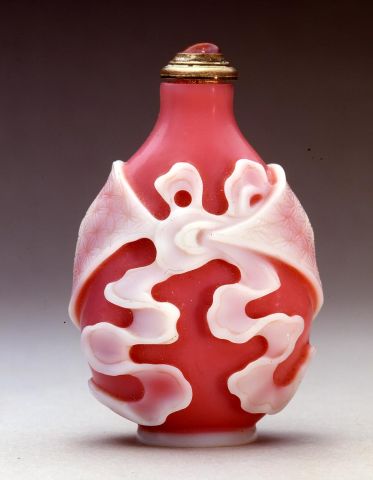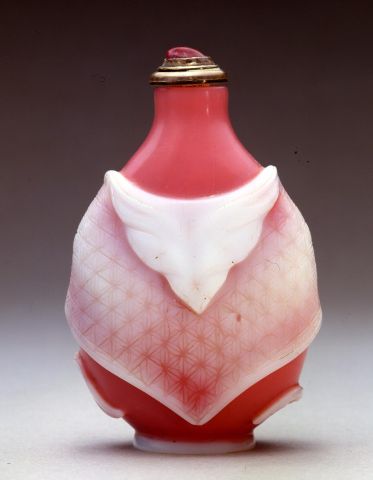

Bottle ID: 00121
PINK, OPAQUE W/WHITE OVERLAY, DRAPED CLOTH
Date: 1736-1795
Height: 69 mm
Glass, of elongated form with sloping shoulders, overlaid in white on opaque pink and carved to depict a diaper patterned cloth folded on one corner to reveal the plain 'lining' and draped around the bottle and tied on the front in a bow with a flowing brocade sash.
Possibly Imperial, possibly attributed to the Palace Workshops, Beijing.
Similar Examples:
Crane Collection nos. 339 and 639
Kleiner, Robert. Treasures from the Sanctum of Enlightened Respect, 1999, p. 89, no. 72.
Lawrence, Clare. Miniature Masterpieces from the Middle Kingdom - The Monimar Collection of Chinese Snuff Bottles, 1996, pp. 242-243, no. 115.174.
Sotheby's, New York, September 14, 2010, lot 21, The Joe Grimberg Collection.
Provenance:
Clare Lawrence Ltd.
A Canadian Collection
Exhibited:
Annual Convention ICSBS Toronto, October 2007
Published:
Lawrence, Clare. Chinese Snuff Bottles from the Dick Hardy Collection and Other Sources, 1991, p. 26, no. 48
This is a design generally found discreetly incised or carved in low relief on nephrite snuff bottles from the eighteenth century and often given an Imperial attribution. It appears rarely on glass examples, usually as a carved monochrome color, such as the transparent celadon green example cited above from the Collection of the Sanctum of Enlightened Respect, where it is given an Imperial attribution. This pink and white example is bolder in its color combination and its confident higher relief carving.
Objects wrapped in cloth and tied with a sash were often given as gifts or birthday presentations. While looking extremely attractive, this method of wrapping also symbolizes a wish for great longevity. The sash (shoudai) represents longevity while the knot (jie) symbolizes infinity. Denis Low points out a further meaning in 'More Treasures from the Sanctum of Enlightened Respect' that the cloth used for this type of wrapping (fu) is a rebus for good fortune or happiness, while the tied (xi) brocade symbolizes the hope for joy.
< Back to full list

 English
English 中文
中文